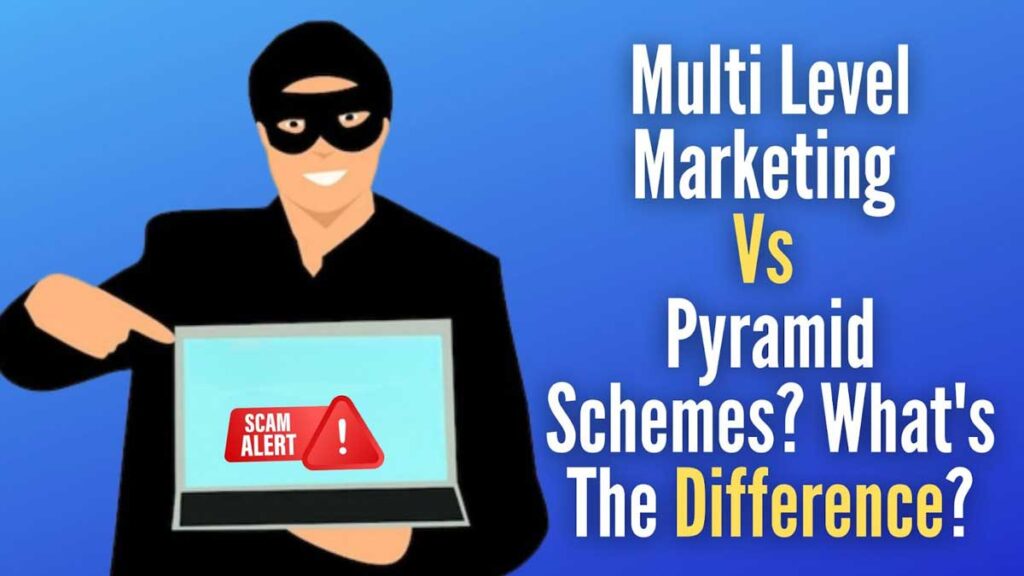
Do you want to work from home or merely add another source of income? Friends may have posted about organic cleaning supplies, self-tanner, or cosmetics. All of those businesses fall under the umbrella of multi-level marketing (MLM) and involve the sale of goods that potential customers may also desire to purchase. The issue is that what you may believe to be one of these respectable revenue sources may instead be a pyramid scheme. Knowing the difference between multi level marketing vs pyramid schemes is essential. This guide will help you do that. So let’s start with the basics.
What Is Multi Level Marketing?
A business strategy called a multi level marketing scheme (MLM) involves hiring additional company sales agents while employing hierarchical, non-salaried sales teams to offer products directly to customers. Other names for multilevel marketing include network marketing and referral marketing.
A community of potential clients is served by existing MLM firm members who sell and advertise the products. As the company’s sales levels rise, they are frequently asked to recruit new individuals to join them.
There is usually a hierarchy of positions or levels within a multilevel marketing company that can be attained through successful sales or recruitment and are connected to rewards and promotions for the associates.
How Does Multi Level Marketing Work?
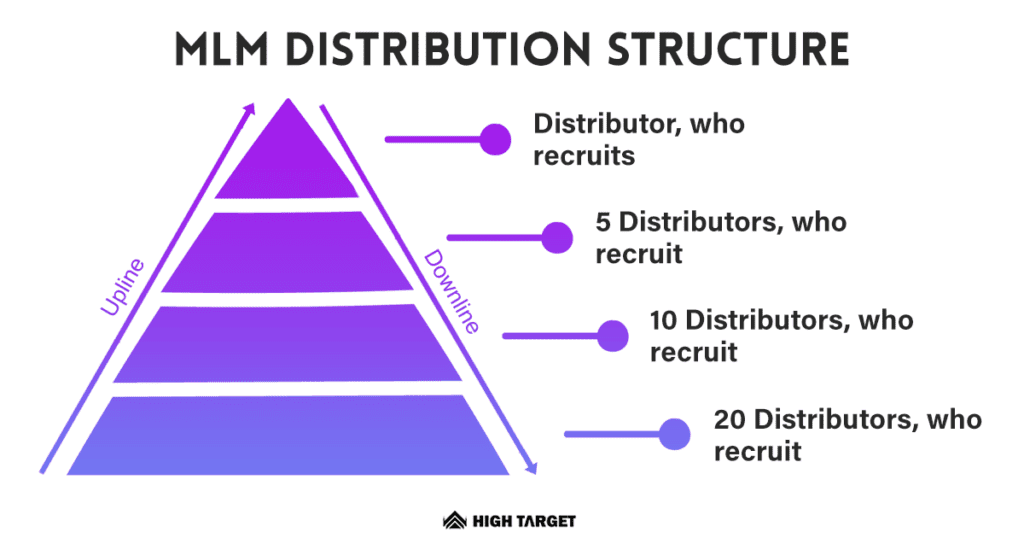
In multilevel marketing, a company that engages in direct sales or business-to-consumer (B2C) sales offers goods or services to single sales representatives who frequently operate as their small business owners.
These agents, in turn, concentrate on selling a good or service directly to customers, typically without a storefront. The independent distributors in the MLM system serve as sales representatives, brand ambassadors, or micro-influencers.
A flat hierarchy, which means there are few levels between the top executives and the newest members, may be part of the organizational structure of an MLM company. The CEO, distributor, sales representative, sponsor, and recruiter are a few possible roles in an MLM company model.
Usually, a compensation strategy is in place. Each person above a sales representative at the bottom level typically receives a percentage of the income when they finalize the deal.
Instead of receiving hourly compensation in MLMs, sales reps receive structured commissions at every level. While finding new distributors is the main objective, the representatives also make money by promoting and selling the company’s goods.
Young mothers, women, and people looking for alternative work frequently join the MLM sales teams. With the promise of freedom and new business opportunities, MLM firms recruit former happy consumers to sell.
The idea that clients may be more likely to trust friends and acquaintances who serve as representatives than total strangers marketing the items is one of the strategies used by MLM companies.
People that use their communities as a source of customers can also discover that their friends and family are eager to support their business endeavors.
Products are frequently marketed in the following methods in MLM:
- Farmer’s markets and fairs
- internet gatherings
- social media marketing campaigns
- home visits
- word of mouth
- Viral marketing
- live or virtual events
- influencer marketing
Examples Of Multi Level Marketing
Amway is a well-known direct-sales organization that makes use of multi-level marketing. Herbalife Ltd., a manufacturer and marketer of dietary supplements and weight-loss products with more than 500,000 distributors is the most well-known multi-level marketing business to defend its business practices. 80% of Herbalife customers do not refer new customers to the company.
What Is Pyramid Scheme?
Pyramid schemes, as their name suggests, have a pyramidal form with the primary person at the top and ever-widening sides as they descend.
A pyramid scheme is a fragile and temporary business model in which top-level participants recruit new members by guaranteeing them a guaranteed commission for bringing new participants into the program. A specific sum known as an upfront cost is imposed against new employees for this reason. These include Ponzi schemes, chain emails, and product-based pyramid schemes.
The pyramid scheme is a type of business model considered unlawful in many nations. Agents grow their networks by persuading friends, family members, neighbors, or other acquaintances to work for the firm as their subordinates.
Each time a new person joins the company, everyone above the chain benefits since a specific part of the profits is paid to them as a commission.
The earnings are solely based on the hiring fees. To maintain a steady income, there must be an endless supply of new members.
How Does The Pyramid Scheme Work?
The scheme is started by a single recruiter who occupies the highest position in the hierarchy and then recruits a second person who invests the specified sum in the scheme, with the proceeds going to the primary recruiter.
As a result, the second person in the hierarchy serves as a recruiter to make up for the investment by persuading more individuals to invest money and join under him so that he can receive more compensation.
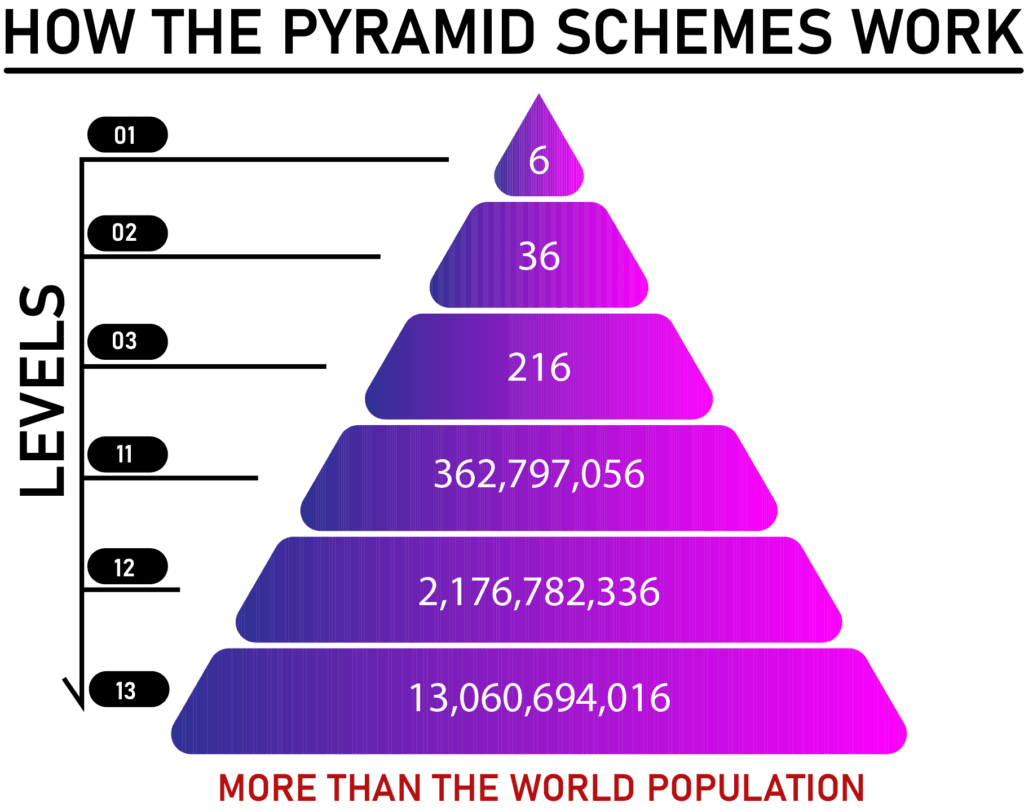
As soon as they are persuaded, they join the organizations and similarly persuade others, and the cycle repeats.
The program grows its membership through seminars, home gatherings, social media connections, phone conversations, or emails. The pyramid scheme is short-lived because the cycle can’t continue when enough people sign up for the program.
Example
The longest-running Ponzi scheme was run by Bernie Madoff. Investors released $17.5 billion into his “investment business” over 20 years. When investors attempted to withdraw $7 billion during the financial crisis of 2008, the scheme was discovered. Madoff could not compensate them due to his low $300 million net worth. He entered a guilty plea and received a 150-year sentence. On April 14, 2021, at 82, Madoff passed away in prison.
We have a separate article explaining in depth about the pyramid scheme. Check it out – What Is The Pyramid Scheme And How It Works.
Key Difference Between Multi Level Marketing Vs Pyramid Schemes
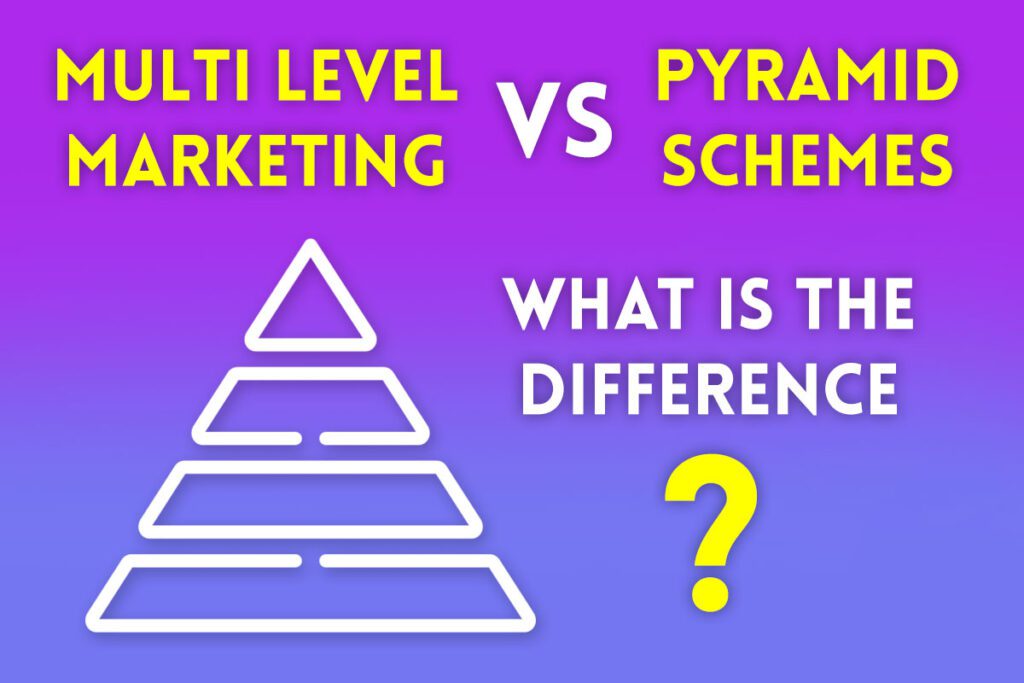
1. Different Setups
There is no underlying product being offered in a pyramid scheme setup. When investors ask for their money back, they are compensated with inflowing funds supplied by subsequent investors.
The portfolio manager, also known as the fund manager, receives money from investors and offers high rates of return (relative to other financial instruments).
However, in multi-level marketing, compensation is paid to distributors at various levels when they sell a tangible product. In MLM, the first participant is responsible for bringing on new investors, who in turn must bring on other investors, who will bring on more investors, and so on.
2. Flow Of Funds
The individual in charge of planning this kind of fraud is responsible for supervising the entire operation in a pyramid scheme. Because money is only transferred from one participant to another, there are no investment opportunities in the financial markets.
However, participants in Multi-Level Marketing are given an incentive. The right or opportunity to sell a certain product is one example of how this incentive is marketed as an investment opportunity.
Each investor pays the individual who signed them up for the opportunity to sell the advertised product, and the person who receives the funds is required to split a portion of the profits with others at higher levels of the pyramid system.
3. Risks
Regarding the dangers involved in each plan, a pyramid scam involves selling a fake investment rather than a real product. MLM is a channel, though, through which a physical good is sold.
As a result of the lack of an underlying product in a pyramid scheme, the dangers involved are greater than those involved with MLM schemes.
4. Promise Of Payment
In a pyramid scheme, prospective members are required to pay a fee upfront before being accepted to be eligible for compensation. Instead of selling tangible goods, these participants make most of their money via enrollment fees.
In an MLM business, however, new members must also pay a price upfront to join, but there is a difference: Members of an MLM program always profit from their product sales in addition to the enrollment fees they pay.
5. Legality
Is multi level marketing illegal? Regarding the legality of each plan, MLM is viewed as a simple marketing scheme with valid products to sell and is thus viewed as lawful. Pyramid schemes are viewed as fraudulent investment management services and are, thus, illegal.
Many people have lost a significant amount of money due to MLM and Pyramid scams, despite being promised extremely high returns and luxurious lifestyles.
Some schemes even go so far as to guarantee and promise returns for members, even claiming that those who participate will be able to quit their jobs quickly because they anticipate earning a huge return in the future.
6. Focus
The way the business is run is another significant distinction between MLM and a pyramid scam.
MLM is a marketing technique. Selling the goods to other multilevel marketing participants is how MLM consultants, contractors, or distributors (as they are known by different businesses) are compensated.
A pyramid scheme, on the other hand, is designed solely to take your money and then use you to recruit others.
Warning: If you are pressured to act quickly and purchase more products than you can resale, you may be dealing with a pyramid scheme.







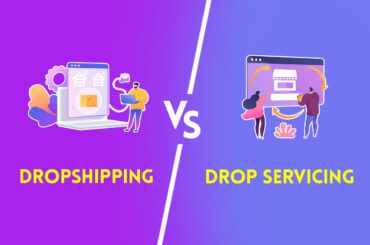
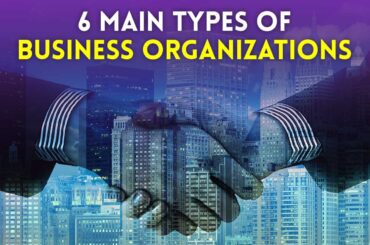




2 Comments
I like this
It’s look so good to be here for more business skills